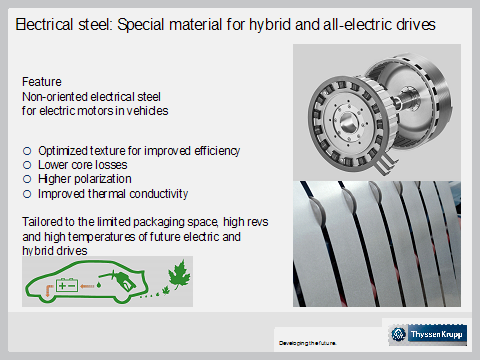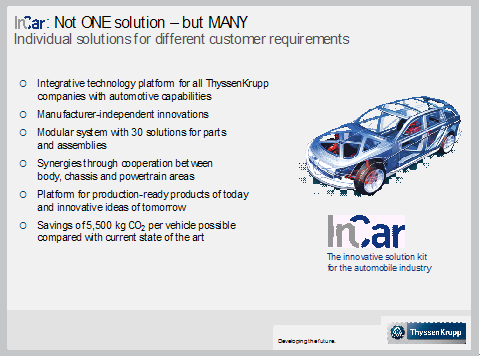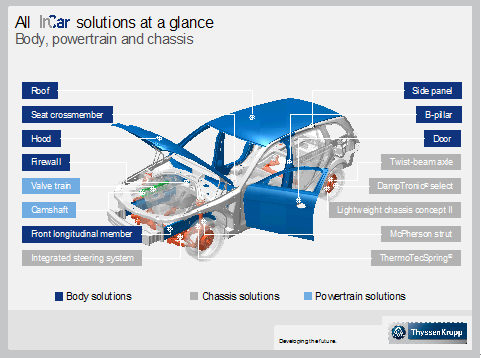所在位置:首页 > 贸促动态 > 市长国际企业家顾问会议 > 往届回顾 > 第九届顾问报告 > 正文
“Efficiency in energy and raw materials use – a crucial aspect in climate policy”
2012年05月23日 来源:中国国际贸易促进委员会北京市分会
Dr.-Ing. Ekkehard D. Schulz, Chairman of the Executive Board of ThyssenKrupp AG
Beijing, May 2010
Climate and environmental policy is one of the central global issues of our time. It is an issue that will occupy us intensely in the coming years. Raw materials and energy sources are scarce, our natural environment is scarce, and time to solve the problems is also scarce. One aspect I will be dealing with here is the efficient use of available resources. Included in this is the development of new, innovative materials. Beijing and its population will profit from developments in climate technology – both economically and environmentally.
Sustainable development in energy and climate policy
China has grown rapidly in recent years and is set to become the world’s second-largest economy. However, there is broad consensus that the growth models of the past cannot be simply carried forward into the future. An economic model that uses up our natural life resources has no future. Ever since the United Nations Conference on Environment and Development in Rio de Janeiro in 1992, sustainable development has been a central goal of global action. All the participants at that conference declared themselves in favor of development that is economically efficient, socially equitable and responsible and environmentally sound. The aim is not to restrict economic growth and living standards but to put them on more sustainable foundations.
There is no doubt that progress has been made since the Rio Conference, even if by no means all expectations have been fulfilled. The rapid growth of the emerging countries could not be foreseen in 1992. The shift from a bipolar world of two superpowers to a multipolar world with various different systems has made political negotiations more complex and at the same time more global. At the last climate conference in Copenhagen, it was not yet possible to achieve the hoped-for breakthrough and sign an internationally binding agreement. The non-binding Copenhagen Accord affirms the goal of limiting global warming and holds out the prospect of funding for climate protection and adjustment measures in the developing countries, but it fails to provide binding and adequate emissions reduction pledges. The Copenhagen Accord therefore falls a long way short of creating a level international playing field.
The expectations for the next climate conference in Mexico are therefore high. The aim should be to establish legally binding and verifiable emissions targets for all parties, including the emerging countries. This would counteract a vacuum after the expiration of the Kyoto Protocol and create a basis for a functioning worldwide CO2 trading system. However it currently appears doubtful whether this can be achieved. What should be avoided is the emergence of regional solutions which would lead to the closing-off of markets and further restrictions on world trade. Climate protection must not be used as a pretext for trade barriers, nor should climate protection costs be allowed to become a competitive disadvantage. In the long term this can only be solved on a global basis.
Climate protection through investment and innovation
Further steps towards a low-carbon economy are necessary. Suitable technological solutions and partial changes to individual behavior can ensure that a low-carbon economy remains compatible with the maintenance of accustomed living standards and adequate economic prospects. Joint efforts by governments and industry are necessary in order to promote investment in climate protection and strengthen the innovativeness of industry. This applies equally to industrialized countries, large emerging nations and developing countries. And it applies at international, national and local level. Governments and industry must work together closely. The job of industry is to contribute to minimizing emissions of greenhouse gases through investment and innovation. Governments must create the right conditions for this. At the same time, a rational information policy must ensure that necessary changes are accepted in society and perceived as opportunities rather than misunderstood as an attack on acquired rights or a limitation of future opportunities.
This includes better international coordination of worldwide research and the strengthening of bilateral and multilateral technological cooperation. On a national level, targeted support for basic research into the development of energy-efficient low-carbon technologies is of major importance, for example through tax incentives for research. At municipal level, cooperation by local businesses and local authorities can frequently open up new opportunities for energy efficiency and climate protection.
The ability of the private sector to innovate and invest is essential for the rapid and widespread use of advanced climate protection technologies. Investments in research and development and the resulting innovations and technology cooperation projects require above all investment certainty. The high cost of developing new technologies can only be justified from a business point of view if the revenues achievable through innovations are available to the companies and research institutes involved. Protection of intellectual property is therefore a very important element for innovations, in climate protection as elsewhere.
Opportunities for industry through climate protection
The market for climate protection offers significant growth potential for industry. According to estimates, the size of the world market will more than double to around 3,000 billion US dollars in the coming years. Germany is a good example of the enormous market opportunities. The country is world-market and innovation leader in environmental technologies, accounting for 16% of world trade in environmental protection products.
The leading position of German industry is also shown in its climate record. Through a variety of measures, companies have succeeded in using energy more efficiently and in a more climate-friendly way. As a result, they were able to meet their self-imposed commitment to reduce specific CO2 gases by 28% in the period 1990-2005. Since 1990, Germany has also shown that it is possible to decouple economic growth and energy consumption. This underlines that economic growth and climate protection can go hand in hand.
However, climate protection must also be cost-efficient and competition-neutral. Particularly with regard to changes in reduction targets it is essential to avoid unilateral burdens. Until there is an international agreement with comparable requirements for all competitors, there is a risk of “carbon and job leakage”, i.e. the shifting of production and jobs to countries with lower
government-imposed costs for energy and CO2.
Opportunities for steel through climate protection
When it comes to climate protection, steel plays a key role. Although the steel industry accounts for a substantial share of industrial CO2 emissions due to the processes used to reduce iron ore to pig iron and convert it into steel, looking at the CO2 emissions generated during the production process only is too narrow an approach. A forward-looking climate policy must also consider the contribution made by steel to reducing emissions.
Taking this comprehensive approach, a first CO2 assessment was recently carried out for the material steel, comparing the CO2 reductions made possible by innovative steel applications with the CO2 emissions caused by steel production.
The result: Steel production in Germany including the extraction of raw materials causes annual emissions of around 67 million metric tons of CO2. Based on very conservative assumptions, this is more than offset by the calculated CO2 reductions of 74 million tons. This assessment deliberately includes only part of the possible savings potential. The greatest potential savings lie in the modernization of fossil fuel power stations, the expansion of wind energy, weight reduction in passenger cars, the increased use of combined heat and power plants and in other renewable energy sources.
This clearly shows that steel has a key role to play in meeting Germany’s ambitious climate targets. By 2020 the German government plans to cut greenhouse gas emissions by 40 percent compared with 1990 levels. That is equivalent to a reduction of 220 million metric tons between 2007 and 2020. The reduction potential of 74 million tons calculated for steel will account for 33 percent of this amount. In other words: The government’s plans for CO2 reductions can only be achieved using innovative steel materials. For technical and economic reasons, it is impossible to replace steel with alternative materials in many areas, and for environmental and climate reasons this would frequently also be counterproductive.
New materials and efficiency enhancements
An efficient steel industry that can supply the necessary innovative steel products is an important contribution towards a successful and sustainable climate policy. The automotive industry is a very good example. In the medium and long term, future car generations will require new drive, component and material concepts. In particular, lightweight construction and new materials will increasingly take center stage; for without weight savings in the vehicle frame or other areas, the efficiency gains offered by new or improved drive technologies could be lost.

An example of new materials: ThyssenKrupp has developed a new electrical steel which is ideal for use in hybrid and electric-powered vehicles. Thanks to its excellent magnetic properties, this new steel grade can make electric motors more powerful and more efficient to meet requirements for environmentally friendly drives for future car generations.
Bioplastics is another particularly attractive market. Lactic acid derived from renewable sources such as sugar, starch or biomass can be used to produce polylactic acid (PLA), a plastic with outstanding mechanical properties which is suitable for use as packaging for fresh foods and in textile fibers. And the material can be recycled or composted, making it highly eco-friendly.
In 2015 it is expected that 292 million metric tons of plastics will be used worldwide. Around 5% of this could be replaced by bioplastics – in packaging, clothing and also in motor vehicles. Compared with today, this would equate to a tripling of market volume.
Carbon fiber composites are another material with a big future, for example in the automotive industry or aircraft construction. ThyssenKrupp is already working on several projects aimed at developing innovations for the production process.
In addition to developing new materials, the intelligent networking of technological competencies is also of major importance. One example of this at ThyssenKrupp is InCar, a cross-Group research project in the field of automotive construction. Our engineers have already developed numerous innovations under this project. This extensive package of manufacturer-independent innovations brings together the entire automotive expertise of the ThyssenKrupp Group. The project offers new solutions for the body, chassis and powertrain. The development priorities under InCar were agreed in close consultation with our customers. InCar delivers innovations which can save more than 17 grams of CO2 per kilometer driven. The ecological assessment of the InCar project, covering the entire product lifecycle, is extremely positive: Taking the whole production and usage cycle into account, the “cleanest” InCar solutions together can reduce emissions by around 5,500 kilograms of CO2 per vehicle compared with the current state of the art at lower cost than currently available solutions and without sacrificing performance or quality.


With a large number of new materials, components and processes we are therefore promoting sustainability and climate protection, saving energy and in so doing protecting the environment. The examples also show how successful solutions can be realized on a cross-sector basis along the entire automotive value chain.
Securing free trade and access to raw materials
With its technological potential, industry will play a central role in global climate protection. To perform its function as a problem-solver, industry is reliant on free access to the necessary natural resources. In the automotive industry, growing demand for electric vehicles will greatly increase demand for metallic materials such as lithium, cobalt, aluminum, copper and the rare earth metal neodymium. Deposits of these raw materials are concentrated to a greater or lesser degree in certain regions. This may result in new import dependencies which can only be moderated to a limited degree by the development of the secondary raw materials market. Against this background, functioning international raw materials markets take on particular importance. Global production capacities must be expanded in good time and to an adequate extent. Above all, however, it is essential to guarantee non-discriminatory access to raw materials. This is not always the case. Some countries seal off their own raw material base to give their domestic industries advantages on the international markets. For example, raw material exports are subject to high taxes or tariffs, or raw material imports are subsidized by tax relief. Anti-competitive behavior and market concentration in the raw materials sector are also impairing the functioning of the raw materials markets. The more trade barriers and protectionist measures in the raw materials sector are relaxed, the sooner we will be able to achieve progress on protecting the environment.
Conclusion for future developments in China/Beijing
These developments affect Beijing as the capital of China in many ways and offer opportunities for the future:
This is where important political and economic decisions are made. As a major city, Beijing can benefit from environmental and climate developments to further improve the standard of life for its millions of inhabitants. That makes Beijing more attractive to domestic and foreign investors.
The development of new materials, components and systems offers Beijing the opportunity to take a leading role in sustainably strengthening China’s industrial base. Creating new jobs is one of the country’s central objectives, and the “green market” offers promising perspectives in this respect.
A pioneering role by Beijing in the development of eco-friendly and energy-efficient innovations would have an impact far beyond the region and would position the city even more strongly as a modern, forward-looking global metropolis.
主办:中国国际贸易促进委员会北京市分会
建设运维:北京市贸促会信息中心
京ICP证12017809号-3 | 京公网安备100102000689-3号


